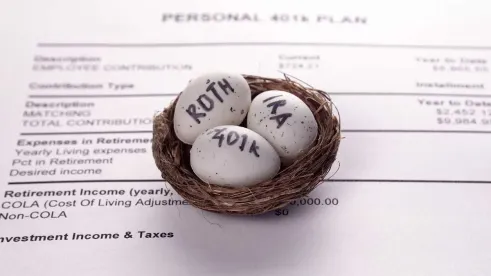With a multitude of questions surrounding implementation and administration, late on a summer Friday afternoon, the IRS issued Notice 2023-62 (Notice), providing Plan Sponsors with a transition period until 2026 to implement Roth catch-up contributions.
Catch-up contributions are a defined contribution plan feature many 401(k) and 403(b) Plan Sponsors are familiar with. Since being introduced in 2001 as part of the Economic Growth and Tax Reconciliation Act (EGTRRA), a catch-up contribution feature allows participants who are age 50 or over in a plan year to make elective contributions that exceed an otherwise applicable limit under the Internal Revenue Code, a plan-imposed limit, or the actual deferral percentage (ADP) limit for Highly Compensated Employees. For 2023, the limit on catch-up contributions is $7,500, subject to indexing in future years.
Enter one of the many tax-qualified retirement plan-related changes enacted as part of the SECURE 2.0 Act of 2022 (SECURE 2.0). SECURE 2.0 provides, among many other things, that effective January 1, 2024, catch-up contributions for participants whose wages (for FICA/FUTA purposes) from the employer sponsoring the plan were more than $145,000 in the prior year must be made on a Roth (after-tax) basis. Further, when the plan provides for mandatory Roth catch-up contributions for those earning over $145,000 in the prior year, the plan must also allow Roth catch-up contributions for all eligible participants.
How hard could it be?
Although simple enough in concept, “flipping a switch” to require Roth catch-up contributions for those earning over $145,000 in the prior year has raised several questions and proved administratively tricky for many.
Not insignificantly, wages for determining which participants must be subject to mandatory Roth catch-ups is not something plans already capture. Designing and testing compliance systems requires a complicated and coordinated effort between Plan Sponsors, recordkeepers, and payroll vendors. With only four months until the statutory effective date, Plan Sponsors have expressed consternation over participant communications, sequencing of which dollars are considered catch-up, obligations related to collectively bargained plans, and the need for further guidance on open questions about whether new participant elections would be needed and mid-year amendment implications for safe harbor plans.
These issues and others have led some Plan Sponsors to consider eliminating all catch-up contributions or at least for those earning over $145,000 in the prior year as a route to compliance. Certainly, not an intended consequence of SECURE 2.0. Other Plan Sponsors considered requiring that any catch-up contribution made only be as Roth for all participants, regardless of wage level.
What is next?
The relief provides important breathing room for plans to work towards compliance by explicitly providing that any catch-up contributions made between January 1, 2024, and December 31, 2025, will be treated as meeting the requirements of SECURE 2.0, even if made only as pre-tax contributions.
The Notice also confirmed that for plan years after 2023, those 50 and over will remain eligible to make catch-up contributions. A technical error in the Secure 2.0 legislation inadvertently eliminated the catch-up provision from the Internal Revenue Code.
The Notice clarifies that additional guidance will be forthcoming. The guidance is expected to include (1) guidance stating that the Plan Administrator and Employer are permitted to treat an election by the participant to make catch-up contributions on a pre-tax basis as an election to make catch-up contributions that are designated Roth contributions and (2) guidance stating that in a plan maintained by more than one employer (including a multiemployer plan), wages are not aggregated between participating employers to determine whether a participant reaches the $145,000 threshold.
The IRS specifically invites comments and suggestions on whether a plan that offers Roth catch-up contributions in order to comply, but not the ability to make Roth contributions generally, violates the provisions of the Code requiring that all eligible participants must be allowed to make the same election regarding catch-up contributions, or whether restricting catch-up contributions to only those participants whose prior year earnings do not exceed $145,000 is permissible.
For those plans that are not far along in implementation, and certainly, for those who have never offered a Roth contribution or Roth in-plan conversion approach, Plan Sponsors may choose to proceed with implementing some design features that move towards compliance. Introducing Roth contributions generally, including the acceptance of Roth amounts in rollover contributions and the ability of all participants to designate catch-up as Roth, may be viewed as plan enhancement before the mandate to require only Roth catch-up contributions for high-wage earners.




 />i
/>i
